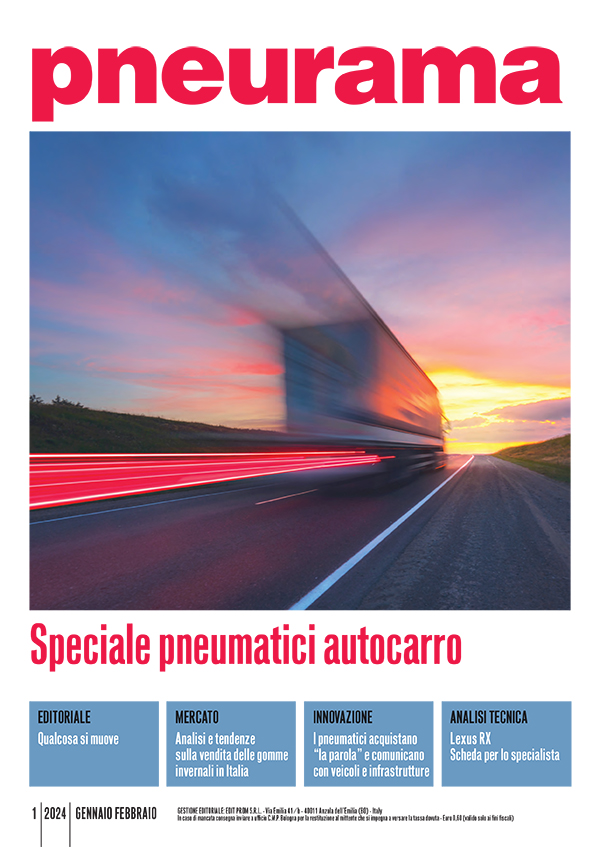Among the many facets of digitisation, computer simulation represents one of the most important and extremely versatile tools for predicting the behaviour of a huge number of products. These tools are used to study everything from natural phenomena, such as atmospheric circulation, the formation of galaxies or the behaviour of an aircraft, a vehicle or, in this case, a tire. The advantages are many, from shorter development times to lower consumption of raw materials, since the number of prototypes built for testing is greatly reduced. The coronavirus pandemic and the resulting lockdowns have also provided an additional impetus in favour of these methods: with R&D as well as testing specialists unable to move around and freely meet each other, simulation has made it possible to carry out a great deal of work on computers rather than on the road, allowing parallel tests to be carried out even at distant sites. Of course, this method also includes driving simulators, which allow a test driver to assess the behaviour of tires with computer generated forces and loads.
Michelin virtual development and racing
One example of the time savings capabilities of virtual simulation is evident from Michelin's development of tires for the new Le Mans Hyper-car class soon to compete in the upcoming FIA World Endurance Championship. These are heavy hybrid racing cars - weighing a minimum of 1030kg - which can either be rear-wheel drive or hybrid all-wheel drive. Pierre Alves, head of Michelin's WEC programme, said the development of these tires was challenging because time was short and, even if you worked closely with the manufacturers, it was impossible to access real cars. All they could do was to use a simulation software, made even more complicated by the fact that these racing cars have the same top speed as the lighter LPM1s but only one aerodynamic configuration for the entire season. Most of the development work was therefore carried out virtually, with track testing only possible for the final approval phase. At the end of the in-house simulation, performed by Michelin’s effective and powerful digital 'resources', the 'physical' prototypes were validated in just 30 hours of testing at the Le Castellet circuit in southern France. The Toyota GR010 Hybrid adopts 31/71-18 tires front and rear, while the other rear-wheel drive cars use smaller tires at the front - 29/71-18 - and larger 34/71-18 tires at the rear.
Siemens software for tire testing and simulation
For those who are unwilling or unable to produce in-house solutions, the market offers third-party solutions: the make-or-buy dilemma can, for example, be solved with Siemens’ Simcenter Tire simulation software. This is a "package" consisting of the actual Simcenter MF-Tire/MF-Swift tire model, the Simcenter MF-Tool tire model parameterisation tool (generates a file of the tire characteristics to be tested) and the tools for road testing. This application is available in several versions to work in conjunction with leading vehicle dynamics simulation software. The MF-Tire and MF-Swift applications are based on the Magic Formula, one of the most widely used semi-empirical models in tire simulation. MF-Swift extends MF-Tire's capabilities to higher frequencies, up to 100 Hz, to predict and model the dynamic behaviour of the "belt" and impacts on 3D obstacles to investigate driving comfort, load prediction (very useful in aircraft landing gear simulation) and vibration analysis. These tools can be used to simulate a variety of situations such as lane departure
when cornering as well as the behaviour of safety control systems such as ABS, ESP, and traction control. The models generated by MF-Tire/MF-Swift work on most industrial real-time operating systems, allowing timely analysis throughout the process. This software allows various simulation methods to be used, including desktop PC applications, and driving simulators, without affecting the results. Finally, Siemens offers a trailer for road testing, with sensors able to detect the forces to which a tire is subjected in various real-world conditions. The trailer measures the tires at camber angles of up to 70 degrees, which means that motorbike tires can also be tested by simulating lean angles.
Continental driving simulator
Ansible Motion, specialized simulators manufacturer, has supplied Continental with the Delta S3, one of its top-of-the-range Driver-in-the-Loop (DiL) simulators. The purpose of this machine, which allows a “physical” driver to 'drive' a simulated vehicle, is to allow Continental's technicians and engineers to test tires comfortably and repeatedly on a wide range of terrains, locations, scenarios, and seasons, all in a virtual setting. Continental stated that by 2030 it aims to become the most advanced tire manufacturer in terms of sustainable and environmentally friendly design and best practices. The Delta S3 simulator could reduce Continental's real-world testing by around 100,000 km per year, using 10,000 fewer tires during the development phase. This equipment will enable rapid and sustainable testing and validation of different tire compounds and structures, finding the best solutions for grip, wear, and smoothness. But the Delta S3 can also be used for testing the dynamic behaviour of a vehicle, be it electric, hybrid or with a traditional ICE engine. Boris Mergell, head of research and development in Continental's tire business unit, pointed out that "developing and testing premium tires is a complex and time-consuming process. By using the new dynamic driving simulator, we will make this development process even more efficient in the future".
The advantages of simulation according to Pirelli
Likewise, almost two years ago, Pirelli outfitted its R&D centre in Milan with a new simulator. This is a VI-grade with a 210-degree cylindrical screen and a 7.5 m diameter, whose job it is to reproduce the environment in which the vehicle is intended to move. The latter is static and includes a driving position (or a whole car) with several devices that reproduce the sensations a driver would have in a real vehicle: the seat, steering wheel and seat belts are active while shakers (elements that convert electrical signals into mechanical vibrations) and other systems replicate the movements of the suspensions and the engine. Purchasing such state-of-the-art equipment allows the tire manufacturer to reduce its product development time and the number of physical prototypes needed. Pirelli believes that this simulator will reduce the average development time of new tires by 30%, both for road and motorsport, thanks to its ability to quickly evaluate virtual prototypes. By maximising virtual development, the use of this simulator reduces the number of physical prototypes and therefore the use of raw materials, a concrete contribution to the sustainability that inspires Pirelli. This simulator looks at a computerised model of any car, whether supplied by the manufacturer or produced in-house, and enters it into the system. Design and development work can also be carried out in parallel on the manufacturer's driving simulator. This guarantees that tire development times keep pace with those of the car for which they are intended, which is very useful as new models come onto the market at an increasingly rapid pace. Testing procedures are coordinated from a control room, from which the parameters of the tire and vehicle specifications can be entered into the simulator and the results of the tests such as tire-road contact forces, tire performance ratings and the assessments of the test driver can be monitored.
Three simulators for Goodyear
Goodyear too showed to rely on VI-grade for its simulators as evidenced by the three that were purchased. The American manufacturer selected a static simulator from the Compact series, which was delivered to Goodyear's R&D centre in Luxembourg, and two dynamic DiM250 (Driver-in-Motion) simulators, one for the Akron, Ohio headquarters, while the other will also go to Luxembourg. Having simulators on 2 continents can give you a competitive advantage in working with car manufacturers given the proximity to their sites. While the Compact series is static, the DiM250 is dynamic, simulating the movement of the vehicle and not just relying on seats, seatbelts, and steering wheel. The driver's position is in fact mounted on hydraulic actuators whose platform can in turn move horizontally pushed by three large hydraulic pistons, tilting forward and backwards to simulate acceleration, or braking much like it happens in a real car. The horizontal movement, which takes place on an air cushion for maximum smoothness, makes it possible to simulate longer accelerations, including the driver's reaction time. This layout leads to a system that is suitable for both low and high frequencies and can therefore simulate vehicle dynamics and comfort respectively. The use of such simulators, enable the development, testing and validation of tire models early in the development cycle, allowing the identification of the best performing tires before building the first prototypes. Goodyear also ordered a training programme from VI-grade, dedicated to testers and engineers, which was delivered prior to the delivery of the DiM250s. This was done to accelerate the learning curve and ultimately increase the return on investment.


